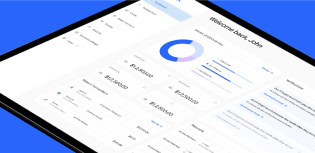Financial reporting for growing teams: 4 steps to stay ahead

Finance leaders: does your month-end close feel like it gets longer (and more stressful) every month? You know the drill: chasing missing receipts, double-checking expense codes and manually reconciling line after line in spreadsheets.
You’re doing your best to deliver accurate reports your leadership team depends on. But with more employees and increasing transaction volumes, it feels like digging yourself out of a deeper hole each month. And no matter how hard you try, errors still slip through.
Let’s face it: growth brings opportunity, but it also brings more data, complexity and pressure to deliver fast, accurate financial reporting. The good news? With the right tools and processes, you don’t have to sacrifice accuracy or burn out your team. Financial reporting can scale with you. But before we get into solutions, let’s look at what’s really driving the strain on your reporting process.
Why financial reporting gets harder as you grow
As companies grow, the demands on finance teams multiply even faster. What once felt like a manageable monthly process becomes nearly impossible. Two factors drive most of this strain: rising complexity and the inability to scale.
Complexity skyrockets
As companies expand, the finance function doesn’t just get bigger; it gets more complicated. Every new employee, vendor or revenue stream adds another layer of data to capture and reconcile. Systems that worked fine at $2M in revenue suddenly buckle under $10M.
Instead of one or two accounts to manage, you’re juggling dozens, with different coding, policies and approval workflows. Manual processes can’t keep up. What used to take a few hours a month now drags on for days, creating bottlenecks and slowing access to the numbers leadership needs.
Scaling breaks down
On top of this complexity, scaling introduces its own set of pressures. The volume of transactions multiplies with every new hire, card and vendor. Fragmentation creeps in as expenses and approvals spread across disconnected systems. And expectations rise as leadership demands faster, more detailed insights to guide decisions.
Together, these forces make reporting feel harder as your growth accelerates. And without the right processes, it quickly becomes unsustainable.
What slow, manual reporting really costs your business
When finance teams stick with manual or outdated reporting processes, the impact goes far beyond a slow month-end close.
- Trust erodes when errors creep into reports
- Agility suffers when leadership doesn’t have timely insights to act on
- Impact declines as finance teams fix problems in lieu of strategic guidance
But the real cost is opportunity. Delayed reporting means delayed decisions. By the time the numbers are ready, the chance to reallocate budgets, respond to a market shift or spot a spending trend has passed. Instead of fueling growth, finance leaders end up stuck in a cycle of catch-up, leaving the business less confident, less informed and less competitive.
4 steps to stay ahead of financial reporting
Financial reporting doesn’t have to get harder as your business expands. You just need to make intentional changes that reduce manual work, improve accuracy and create real-time visibility for your team. Here are 4 steps to get started.
Standardize and automate data collection
The more consistent your data is at the point of entry, the smoother reporting becomes. Automating receipt capture, expense coding, transaction matching and reconciliation reduces errors before they happen and saves hours of manual work at month-end.
- Standardize and automate data collection
The more consistent your data is at the point of entry, the smoother reporting becomes. Automating receipt capture, expense coding, transaction matching and reconciliation reduces errors before they happen and saves hours of manual work at month-end.
- Leverage payment methods with built-in spend controls
Payment methods that enforce rules at the point of purchase, such as virtual cards with category limits or pre-set budgets, make compliance automatic. By controlling how funds are spent up front, you reduce policy violations, capture accurate data instantly and avoid time-consuming fixes later.
- Create smarter approval workflows
Ad hoc approvals through email or chat slow down the close and create bottlenecks. Centralized, rules-based workflows speed up the process while ensuring compliance. When every expense follows the same path, reporting is faster, cleaner and audit-ready.
- Integrate your financial systems
Disconnected systems create duplicate work and inconsistent data. Integrating expense reporting with accounting tools ensures information flows seamlessly, reduces reconciliation headaches and gives leadership a single source of truth.
These four steps combined create one powerful outcome: real-time data you can trust. With clean, accurate information flowing in continuously, reports are more reliable and finance leaders have the visibility they need to guide decisions as the business evolves.
How PEX transforms financial reporting for growing teams
With the right platform, these four steps are simple to put into practice. PEX provides the infrastructure that gives finance leaders continuous, reliable reporting.
- Automate data collection: Capture receipts automatically via text, email or app upload and apply pre-programmed GL codes. Automated reconciliation tools match and verify transactions instantly. The result is clean, accurate data flowing in continuously, so reports are faster and more reliable.
- Control spend at the point of purchase: Set limits by vendor, category or dollar amount with PEX’s virtual, physical and prepaid cards. Transactions are logged instantly, ensuring reporting data is accurate at the source—no last-minute fixes required.
- Streamline approvals: Automated workflows route requests through the right path every time, whether it’s a single sign-off or multi-level approval. Expenses stay audit-ready, eliminating delays and making month-end close smoother.
- Integrate with accounting systems: Direct connections with a variety of accounting platforms keep data flowing seamlessly, reducing reconciliation headaches and strengthening financial oversight. These integrations also support month-end close automation, helping teams shorten the close cycle and deliver reports faster.
PEX customers see the difference. For example, Family in Christ Community Church used card controls and approval workflows to enforce consistent expense policies, improve compliance and ensure cleaner data in their financial reports. On average, our customers save 657 hours each year through automated and AI-enabled reconciliation.
Ready to see it in action? Book a demo to learn how PEX can save your team hundreds of hours a year and deliver the accurate, real-time financial reporting your business needs to grow with confidence.
Similar resources
Opinions, advice, services, or other information or content expressed or contributed here by customers, users, or others, are those of the respective author(s) or contributor(s) and do not necessarily state or reflect those of The Bancorp Bank, N.A. (“Bank”). Bank is not responsible for the accuracy of any content provided by author(s) or contributor(s).











